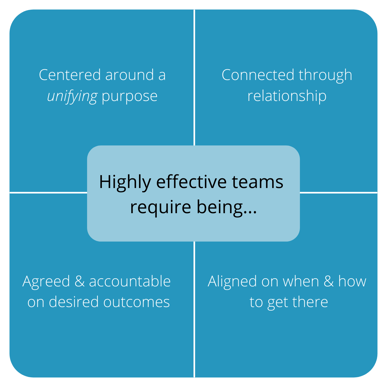Four Dynamics of Highly Effective Teams
Dynamic #2: Connected through relationship
During the past eighteen months and in large part because of the challenges that COVID-19 has brought to the workplace, teams have become more important than ever in determining the success of organizations.
Every team, just like every individual, is different. Yet, there are four dynamics evident in every thriving team. In this series of blogs, we are unpacking these dynamics – today it’s Dynamic #2: Connected Through Relationships.

The above chart also represents how the process approach can impact the work of your team!
Dynamic #2: Connected through relationship
In working with teams, especially those at the top of an organizational system, such as a board of trustees or the organization’s leadership team, I’ve noticed that their ability to perform is in direct correlation to their level of functioning relationship within the team. The higher level of relationship, the higher functioning the team…the lower level of relationship, the lower functioning the team. Being connected to another person on a team, means that there is a level of relationship present.
As you can imagine, this relational dynamic has many factors in play: an individual’s openness, ability to communicate, and willingness to be vulnerable come easily to mind. In addition, developing a closeness of relationship with your team members can also be very helpful. Knowing each other well and at a personal (and appropriate) level helps to support a sense of interconnection and belonging, like parts of a greater whole.
In their recently published 2nd Edition of Humble Inquiry, Ed and Peter Schein calls this a type of relationship a Level 2 relationship. “Level 2 implies getting to know each other at a more personal level in order to develop a higher level of openness and trust.” This type of relationship creates a space where a team members can handle surprises and complexities in their work together. With regards to teams, the authors go on to say, “Level 2 relationships offer the promise of flexibility, adaptability, and resiliency, which derive from group members and their leaders learning the gentle art of asking instead of telling.”
Here is a recent example that testifies to Schein’s concept of Level 2 relationship. About nine months ago, I began working with a president and his leadership team. The purpose of our time together was to begin designing a transformation process that would assist the organization in adapting to its changing business environment and the new realities the company was facing.
As we began working together, I noticed that not everyone in the room experienced this level of relationship with each other. Some clearly had a Level 2 relationship, others experienced something less, a more transactional relationship (what Schein calls a Level 1 relationship). This made me very curious about why this dynamic existed.
Along with the president, we began to scratch a little deeper to understand more about why some of the members approached the team from a ‘Level 1’ perspective. Through a series of conversations, it became clear that not everyone valued each other’s work equally, some team members didn’t feel safe within the team setting, and even others felt that their time would be better utilized elsewhere.
When we are connected through relationship to a teammate, we see them, we understand them, and we know them. This also means that they have value in our eyes. They are important and the work they do in service to the team and larger organization is essential and without it the team would falter. Returning to Humble Inquiry, the Scheins call this a personalized culture. A team culture where people are seen, heard, appreciated, trusted, and valued. A place where deep relationship exists.
Over the course of the next several months, the president’s team began to create time to get to know each other at a personal level. They spent time together outside the office, had lunch together, and even took time to learn each other’s personal histories. These relationship development experiences paid huge dividends when it came to the team’s effectiveness and their ability to move together to implement the organization’s new strategic plan.
Something else emerged that was refreshing…they began to get along better.
If you would like to talk about how to help your team thrive, please feel free to schedule a high-value 30-minute discovery call with me. I'd be honored to listen.
As always, please feel free to call me at 616.516.9870 or email me at lons@designgroupintl.com.
Walking alongside you,
 Lon L. Swartzentruber
Lon L. Swartzentruber
CEO, Design Group International
Senior Design Partner
Tags:
process consulting, capital campaigns, donor clarity, Design Group International, Fundraising, donor relationships, leading organizational change, donor development, advancement, listening, helping, future, learning, organizational consulting, past, present, relationships, A Cause Greater Blog/Lon%20L.%20Swartzentruber%20Headshot%20(300x300).png)
September 28, 2021
.png?width=525&name=March%20Post%20-%20DGI%20Blog%20Post%20Image%20(2).png)

Comments